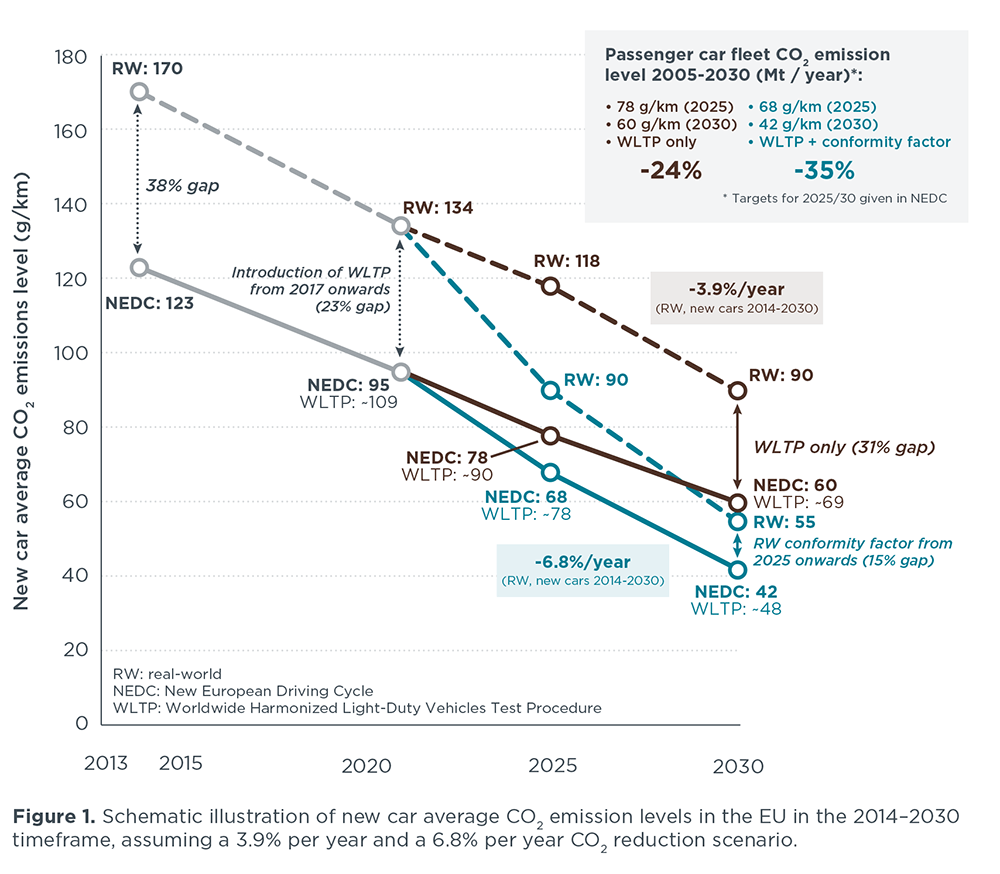Press release
Deeper reductions in car CO2 emissions are both technologically feasible and economical, especially if manufacturers promote electric drive—study [press release]
A CO2 target of 70 g/km for new cars in the EU could be met with very little electrification and with an average payback period of less than 4 years.
But transitioning soon to electric drive could lower manufacturers’ compliance costs by as much as €500 per vehicle in 2025
Average new car CO2 emissions must decrease from the present 120 grams per kilometer (g/km) to 95 g/km by 2021 under current European Union regulation. No further reductions are presently mandated, but new targets for 2025 and 2030 are under discussion in Brussels. In 2013 the European Parliament recommended an “indicative range” of 68–78 g/km for 2025, while holding out the possibility that even lower targets should be considered if justified.
A new study by the International Council on Clean Transportation uses detailed computer simulations and bottom-up technology cost estimates to show what CO2 target levels can be achievable at what incremental costs.
“Our analysis shows that a CO2 target of 70 g/km for 2025, on average for the entire new car fleet, can be achieved with either no or only modest levels electric vehicle penetration,” said Dr. Peter Mock, Managing Director of ICCT Europe. ” The total technology cost increment would be between €1,000 and €2,150, and the fuel cost savings would be on the order of €450 per year.”
Deploying the full range of combustion engine technologies, including hybrid electric vehicles, would be sufficient to reduce the fleet average CO2 emissions to 70 g/km, the study found. “The average car buyer would recoup the investment in vehicle-efficiency technology after 3 to 4 years, and save thousands of Euros more over the lifetime of the vehicle,” concludes Dr. Mock.
While a CO2 target of 70 g/km could be met without significant deployment of electric vehicles, the study found that exhausting all the potential gains from combustion engine technology improvements before transitioning to electric drive would be a relatively costly approach for vehicle manufacturers. Switching sooner from conventional gasoline and diesel vehicles to plug-in or battery electric vehicles would reduce compliance costs.
“For 2025, manufacturers can meet a 70 g/km CO2 fleet target for €200 to €500 less per vehicle if they would start deploying electric vehicles earlier, and aim to reach a market penetration level of about 15 per cent by 2025,” explained Dr. Mock. The underlying reason: drastic reductions in battery costs in recent years. “We are already seeing that some European vehicle manufacturers, like Renault-Nissan and more recently Volkswagen, appear to be pursuing that product strategy.” For the year 2030, the ICCT study considers CO2 fleet target values of 40 g/km and lower as reachable, assuming that electric vehicles would make up a large share of new-vehicle sales by then.
Lowering the official average CO2 emissions of new cars will not by itself mean that Europe is making progress toward its climate goals. As another new ICCT report notes, the gap between official emissions values and real-world emissions in everyday driving continues to grow, reaching 42% in 2015.
A new vehicle type-approval test procedure for the EU, the Worldwide Harmonized Light Vehicles Test Procedure (WLTP), will likely reduce that gap beginning in 2017. But the WLTP also contains loopholes that manufacturers will be able to exploit, and the CO2 gap could grow again. “It is important that the European Commission not only set new car CO2 targets for 2025 and 2030 but also limit the gap between laboratory and real-world levels by defining an on-road conformity factor for CO2, as it has already done for air pollutants,” said Dr. Mock.
Contact: Peter Mock, peter@theicct.org
Publication details
2020-2030 CO2 standards for new cars and light-commercial vehicles in the European Union [Briefing paper]
CO2 reduction technologies for the European car and van fleet, a 2025-2030 assessment: Methodology and summary of compliance costs for potential EU CO2 standards [White paper]


